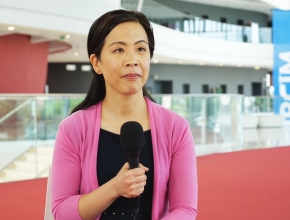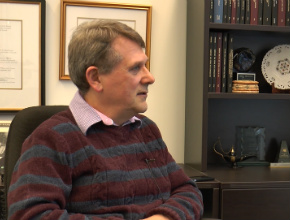References
Douketis JD, Spyropoulos AC, Kaatz S, et al; BRIDGE Investigators. Perioperative Bridging Anticoagulation in Patients with Atrial Fibrillation. N Engl J Med. 2015 Aug 27;373(9):823-33. doi: 10.1056/NEJMoa1501035. Epub 2015 Jun 22. PubMed PMID: 26095867.Roman Jaeschke: Hello, welcome to McMaster Perspective. I would like
to introduce to you Professor James Douketis, an expert in perioperative and
periprocedural antithrombotic therapy and bridging, a person who has been
participating in writing practice guidelines on this topic for number of
years.
Jim, you had a major study published recently. Could you describe the
study and its findings to our audience?
James Douketis: First of all, thank you. It is my pleasure to share my
thoughts with you. Dr. Jaeschke is referring to the BRIDGE trial. This was a
large randomized trial that asked a very simple question, and that question was:
In patients who are receiving warfarin and require its interruption for an
elective surgery or procedure, is there any benefit to administering a
short-acting anticoagulant – in this case, a low-molecular-weight heparin – as bridging before and after the procedure?
Going into the study, there were two hypotheses. The first was that bridging would not confer any benefit in terms of mitigating the risk for adverse thromboembolic advance, and that it may in fact cause harm by increasing the risk for perioperative bleeding. The protocol that was developed was done in a way so that the bridging arm would be given the best chance to succeed. How was that done? First of all, a therapeutic dose of
low-molecular-weight heparin was given to optimize its efficacy. But at the same
time, the bridging was administered in a flexible manner, so that we would
optimize the safety. In patients having a minor procedure, bridging could be
started within 24 hours afterwards. If they were having a major surgery on the
other hand, then the protocol allowed a 48- to 72-hour window to resume
bridging, and so to provide the winning conditions for the bridging arm. Of
course, this was a double-blind, placebo controlled trial, so patients and their
caregivers did not know which treatment they were receiving.
What were the
results? First of all, the rates of thromboembolism were quite low, less than
half of 1%, but the same essentially in the bridging and no-bridging arms, so
they were not inferior according to the prespecified outcomes. Bridging was
associated with about a 3 times higher risk for major bleeding. It was 1% in the
no-bridging group, above 3% in the bridging group. So the conclusions from this
study appear to be that bridging anticoagulation, although well-intentioned and
has been used for a number of years, maybe does not do what we had intended it
to do, which was to mitigate, reduce the risk for thromboembolism. And as we had
hypothesized, in fact it may cause harm by increasing the risk for perioperative
bleeding.
RJ: Thank you. Do you mind telling us a little bit more about the populations of people who were studied – who were those people, what kind of procedures were they undergoing, and why they were anticoagulated in the first place?
JD: The study population for BRIDGE was exclusively patients with atrial fibrillation, and they were all undergoing an elective procedure which at the discretion of the treating doctor required warfarin interruption. That is a dominant group of patients who are receiving warfarin or other anticoagulants. The BRIDGE trial did not include patients with mechanical heart valves, aortic or mitral, and it did not include patients with a recent stroke or thromboembolic event within the previous 3 months. So the results of the trial would not apply to those patient groups.
RJ: In this case, would this be the population of people you would still consider bridging these days? You are running the bridging clinic at McMaster. Who would be the people to whom you would say: OK, we are not changing therapy, what we used to do, on the basis of the BRIDGE trial, we will still use bridging. What kind of patients would that be?
JD: That is an excellent question because we still do not have any good evidence on whether we should bridge or not bridge patients, let's say, with a mechanical heart valve. In my practice, for what it is worth, I continue to bridge patients with any kind of mechanical mitral valve and patients with an older, mechanical aortic valve, and patients with atrial fibrillation who may have a very high CHADS score, let's say 5 or 6, or have had a recent stroke or transient ischemic attack (TIA) within the past 3 months or so. So there is still a need for bridging. The BRIDGE trial offers an additional benefit though in that it gives us a way to bridge patients in a manner that is safe, so that it can be applied to those individuals in whom bridging is still, at least in my view, warranted.
RJ: In terms, again, of population, you mentioned that you were investigating patients in whom the person or surgeon performing the procedure wanted not to have the anticoagulation effect. Are there procedures, operations, where you would consider interruptions not needed in the first place?
JD: Of course. There is a number of procedures that are very common, where a complete interruption of warfarin is not needed. I am referring to minor dental procedures, 1 or 2 teeth being extracted, or a root canal; cataract surgery, which is largely avascular; coronary angiography, especially through the radial approach; and now there is an increasing evidence that even more involved procedures, like placement of a pacemaker or internal cardiac defibrillator, do not require interruption of warfarin therapy. So there is a number of common procedures where warfarin does not need to be interrupted. The only proviso there is that at the time of the procedure you would like the international normalized ratio (INR) to be maybe on the lower side, between 2 and 2.5.
RJ: Another question which I wonder how you handle in your practice and in the trial: There is a number of people these days both on anticoagulant and antiplatelet treatment. Could you make any comment how you handled it and how do you handle it in your day-to-day practice?
JD: This type of patients who are on combined antiplatelet and anticoagulant agents are typically those who may have a mechanical mitral or in some cases an aortic valve, or patients with atrial fibrillation who may have had coronary bypass or have a coronary stent. In these patients, in addition to interrupting their warfarin – let's assume they are having a more involved procedure where the bleeding risk requires that warfarin is interrupted – the question is: Would you continue or interrupt the aspirin? And we know from the large POISE-2 trial that continuing aspirin around the time of the surgery will increase your risk for major bleeding by about 1%. So having that knowledge, you have to individualize management. For example, if I had a patient who had a coronary stent within the last year or two, I probably would continue the aspirin, knowing that I am probably going to increase their risk for bleeding a little bit, and maybe discuss that with the surgeon or proceduralist, so they are aware of that and they can take interventions in the operating room (OR) to mitigate the risk for bleeding. But other patients, if they have been on aspirin and warfarin, let's say, for a mechanical mitral valve, they are going to be bridged anyway, so the role of continuing aspirin is less important with bridging, and I would interrupt aspirin in most patients, with some exceptions.
RJ: Probably the last question here: When you are not bridging, what would be your usual advice for patients – when to stop, when to start?
JD: If they are on warfarin, typically we want to have them off the drug for 5 days before their procedure or surgery. What we do after the surgery or procedure is we typically restart the warfarin the same evening. So let's say they are having a colonoscopy and maybe a polyp removed. We would stop the warfarin 5 days before and ask them to resume it the evening after the procedure. And sometimes, in fact, what we do is we increase their dose that evening to allow them to be reanticoagulated faster. We do this because, as you know, warfarin takes at least 2 days, sometimes more than 3 or 4 days, for it to have an anticoagulant effect. If the patient is on acenocoumarol, the interruption interval is shorter, 2 to 3 days; if they're on phenprocoumon, longer, 10 to 15 days' interruption.
RJ: I promised it was the last question, but I have a follow-up then. You mentioned colonoscopy and polypectomy. What in your opinion is a reasonable extent of gastroscopic or colonoscopic procedures to be done without interruption of anticoagulation?
JD: That is an interesting question because it obviously depends on the indication for the endoscopic procedure. If you know very well that that procedure will be done, let's say, for surveillance of colon cancer and there will not be plans to do multiple biopsies or polyps, you probably do not need to interrupt warfarin. But in probably most cases there is some element of uncertainty, and the safe approach would be to interrupt the warfarin so as to allow that proceduralists who do the biopsy or remove the polyp do not have to bring the patient back if the warfarin was not interrupted to repeat the procedure. You would want to avoid that.
RJ: Thank you very much.
JD: You are very welcome.
 English
English
 Español
Español
 українська
українська





